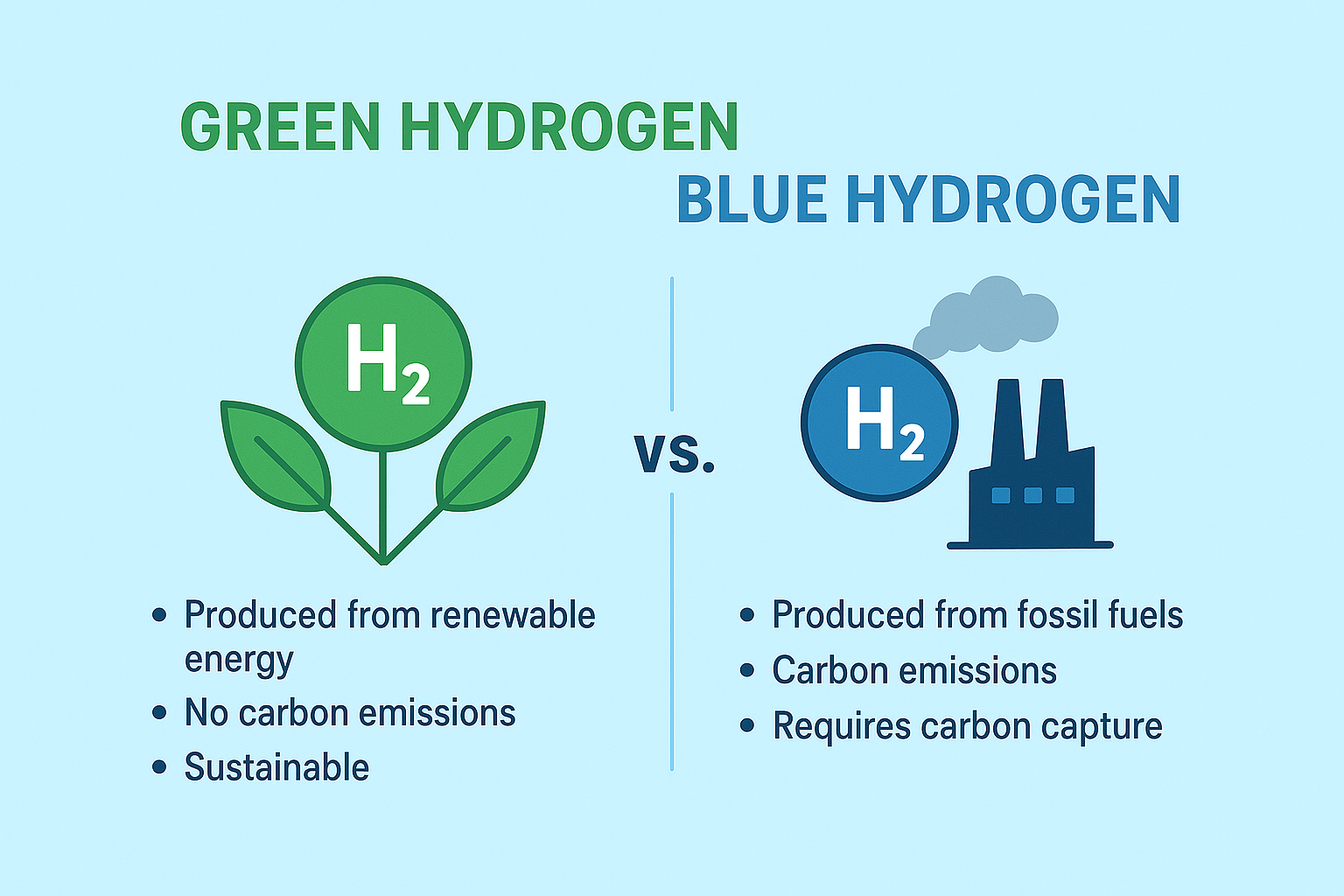
Hydrogen is emerging as a cornerstone of the clean energy transition, but not all hydrogen is created equal. Two of the most discussed forms — Green Hydrogen and Blue Hydrogen — represent distinct pathways toward decarbonization. Both aim to reduce reliance on fossil fuels, but they differ in production methods, costs, carbon footprint, and scalability.
For industries, policymakers, and investors, understanding the difference between green and blue hydrogen is crucial to making informed choices in the journey to net-zero.
What is Green Hydrogen?
Green hydrogen is produced through the process of electrolysis, where water (H₂O) is split into hydrogen (H₂) and oxygen (O₂) using renewable electricity such as solar, wind, or hydropower.
Key Features:
- Zero direct emissions – No carbon dioxide is released during production.
- 100% renewable – Relies entirely on clean energy sources.
- Scalable for future demand – Can integrate into grids powered by renewables.
Challenges:
- High production costs due to expensive electrolyzers and renewable energy infrastructure.
- Energy-intensive process requiring large amounts of green electricity.
What is Blue Hydrogen?
Blue hydrogen is produced by reforming natural gas (methane, CH₄) into hydrogen and carbon dioxide. Unlike gray hydrogen (which vents CO₂ into the atmosphere), blue hydrogen incorporates Carbon Capture, Utilization, and Storage (CCUS) to trap and store emissions underground.
Key Features:
- Lower emissions than traditional hydrogen from natural gas.
- Uses existing natural gas infrastructure, making it more accessible in the short term.
- Bridge fuel for industries transitioning from fossil fuels to renewables.
Challenges:
- Not fully carbon-free – Some CO₂ emissions still escape capture.
- CCUS is expensive and not widely available in all regions.
- Dependent on fossil fuel supply, which poses long-term sustainability issues.
Green Hydrogen vs. Blue Hydrogen: A Quick Comparison
|
Feature |
Green Hydrogen 🌱 |
Blue Hydrogen 🔵 |
|
Production Source |
Renewable electricity + water electrolysis |
Natural gas + CCUS |
|
Carbon Emissions |
Zero (if powered by renewables) |
Low, but not zero |
|
Cost (2025) |
$3–6 per kg (falling) |
$1.5–3 per kg |
|
Infrastructure |
Needs new renewable & electrolyzer setups |
Uses existing natural gas pipelines & plants |
|
Scalability |
Long-term sustainable solution |
Short- to medium-term transitional solution |
Why Both Matter for Net-Zero Goals
- Green hydrogen represents the ultimate clean solution but needs large-scale investments and falling renewable costs to become affordable.
- Blue hydrogen serves as a transitional step, reducing emissions while leveraging existing fossil fuel infrastructure.
Together, they form a hybrid pathway where blue hydrogen supports near-term decarbonization while green hydrogen scales up for long-term energy sustainability.
Industries Driving Hydrogen Adoption
- Steel & Cement: Replacing coal and natural gas with hydrogen in furnaces.
- Transportation: Fuel-cell vehicles (trucks, ships, trains, and aircraft).
- Power Generation: Hydrogen-fired turbines as backup for renewables.
- Chemicals: Ammonia and methanol production powered by low-carbon hydrogen.
The Road Ahead
Hydrogen is not just a fuel — it’s a pillar of the global energy transition. While green hydrogen is the endgame, blue hydrogen will play a critical role in the short to medium term, especially for industries and regions not yet fully equipped for renewable-only infrastructure.
The future energy mix will likely be a combination of both, gradually shifting from blue to green as technology advances, costs fall, and renewable capacity expands.
Conclusion: Choosing the Right Hydrogen Path
The “green vs. blue” debate isn’t about competition, but about timing. Blue hydrogen offers immediate decarbonization potential, while green hydrogen ensures a sustainable long-term future. Together, they can accelerate global progress toward net-zero emissions and a resilient energy ecosystem.




